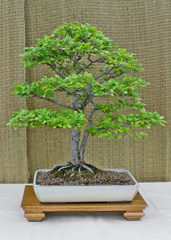Botany Basics - Part 7:
Alkaloids (continued from Part 6)
Alkaloids are among secondary products known as phytotoxins that are poisonous to animals. Some plant species have phytotoxins distributed throughout the whole plant while others are found in specific parts of the plant. It is not explainable why rhubarb petioles may be safely eaten, when their attached leaf blades contain enough oxalic acid to cause muscle and kidney damage, coma and even death. Or why roots and shoots of a tomato plant, but not it’s fruit and seeds, should contain the violently toxic alkaloid, solanine. Fortunately, many phytotoxins cause vomiting, a reaction that purges them from the body before their more sinister work is undertaken.
When eaten, most plant poisons inhibit digestive processes or strike directly at the functions of the heart, liver, kidney or central nervous system. Less harmful species, such as poison ivy, simply produce substances that, on contact, cause skin irritations.
I am listing some common house and garden plants and their toxic parts. This is not intended to be a complete listing by any means.
Amaryllis – bulbs
Anemone – entire plant
Apple - seeds and leaves
Apricot – seeds and
leaves
Asparagus – berries
Azalea – entire plant.
Buttercup – entire
plant
Caladium – entire plant
especially tubers
Daffodil – bulbs
Eggplant – leaves and
stems
Holly – berries
Hyacinth – bulbs
Hydrangea – entire
plant
Iris – leaves and rhizomes
Ivy – berries and leaves
Lily of the valley
– entire plant
Mistletoe – entire
plant especially berries
Morning Glory – Seeds
Peach – leaves and
seeds
Philodendron – entire
plant
Poinsettia – Leaves,
stems, milky sap
Potato – leaves, stems,
green tubers, sprouts
Wisteria – pods and
seeds
It is inevitable that photosynthesizing plants should be the targets of destruction by animals since, in the ecosystem, one is the primary food producer and the other, the principal consumer. These defenses are essential to the plants survival.
Wound Healing
Epidermis and cork, the surface tissues of plants, act as barriers between a plant’s interior and external environment. Cutin, produced and superimposed on epidermal cells prevents water loss from leaves and stems and bars entry of fungal spores. Suberin, a substance in the walls of cork cells, inhibits water loss from woody stems; whereas tannin, another chemical present in cork, acts as a natural fungicide and insecticide.
Injury to either the epidermis or cork results in uncontrollable water loss and the formation of openings through which unwelcome organisms find ready access to the plant’s interior.
An opening made in herbaceous tissues is initially sealed by the exposed cells on the wound surfaces which collapse and die. Then a waxy substance, similar to cutin and suberin, form a callus, a parenchyma tissue, over the exposed wound. Cork then slowly encoaches from the area around the wound. A few years after a branch is trimmed from a tree, cork development may have completely obliterated the wound. For healing to be effective, it is important that woody branches be cut close to the supportive trunks, since it is difficult for cork to grow over projecting stubs.
In many species, exudates form effective barriers between injured and healthy tissues. Conifers produce a sticky, aromatic fluid called resin that oozes from specialized resin canals when they are broken. It is insoluble in water and hardens on exposure to air. Gums are different from resins in their chemical composition and are water soluble, viscous liquids, that also dry to form hard coats on wounds. Latex is a white or colorless exudate that contains, among other components, rubber particles that effectively seal scars and wounds.
Latex, resins and some gums are know to have bacterial, fungicidal and anti-herbivore properties.
In this series of articles, I have tried to expose the unseen functions of plants. I hope this additional information will help you in the understanding, care and maintenance of your trees.
Please click on one of the links below:

